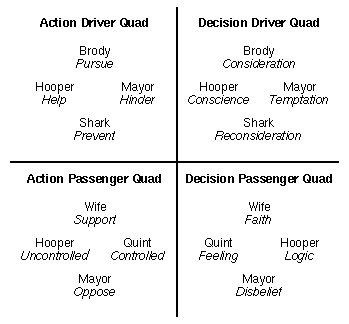The following is excerpted from a class on story structure presented by co-creator of the Dramatica theory of story, Melanie Anne Phillips, signed on as Dramatica.
Dramatica : The Main Character is not necessarily the Protagonist. First of all, a Protagonist is an archetypal character, and although archetypes work just fine, there are an infinite number of other kinds of more complex (and more simple) characters that can be created. But suppose we have a story with a Protagonist, and the Protagonist is NOT the Main Character… A story like To Kill a Mockingbird.
The Protagonist of a story is the driver of the Objective story. In other words, they are the most crucial soldier on the field. But we don’t have to see they battle always through their eyes. Just like we don’t always have to identify only with the quarterback in a football game. In To Kill a Mockingbird, Atticus, the Gregory Peck part in the movie, is the Protagonist. He is the driver of the Objective story – the story all the characters are concerned with. He is the one who wants to have the black man wrongly accused of rape freed. Do the two of you know the story?
Dan Steele : Unfortunately, not too familiar with the plotline.
RDCvr : Sort of, saw the movie a long time ago.
Dramatica : Well, the parts we are interested in are pretty simple, so it shouldn’t hold things up. The antagonist of the story is Bob Ewell, the father of the girl who was supposedly raped. He wants to have the man executed or at least lynched. But, the Main Character, the one through whose eyes we see the story through is Scout, Atticus’ little girl. The audience identifies with her, and even the camera angles in the movie are from her eye level whenever she is in a scene.
In this story, the Obstacle Character is not the antagonist either. The Obstacle character is Boo Radley, the “boogie man” from next door. The author of the work, in dealing with prejudice, did a very clever thing, in separating the Main and Obstacle from the Protagonist and Antagonist. No one wants to admit they are prejudiced. So, in the Objective story, the audience looks AT Atticus and Bob Ewell, and passes judgment on them. But at the same time, we are sucked into being prejudiced ourselves from the very first scene, because of the way Scout feels about Boo.
At the end of the story, we realize emotionally, that we were just as wrong as the objective characters were. Very clever technique! About to change subject, any questions?
Dan Steele : Okay, clear on the functions/differences of Main/Protagonist/Obstacle Chars.
Dramatica : Great!
RDCvr : what is the difference between obstacle character and antagonist?
Dramatica : The Antagonist tries to prevent the Protagonist from achieving the story’s goal, the Obstacle character tries to get the Main Character to change their belief system.
RDCvr : Okay.
Dramatica : They do this by building an alternative paradigm to the one the M.C. has traditionally used. More often than not, the M.C. and Protagonist characters are put in the same “body” and so are the Antagonist and Obstacle.
Dan Steele : Fine, but what if the antagonist is the protagonist, as in man against himself?
Dramatica : In Dramatica, we call any body that holds a character a player. Actually, you have touched on some very important theory points. First of all, when it comes to the Antagonist and Protagonist and all the other “objective” characters, the audience sees them “objectively” from the outside. Therefore, we identify them by their function in the story.
Again, we can feel for them, but we must see their function in order to understand the meaning of the battle. So, putting two objective functions that are diametrically opposed into the same player, mask the function of each, and make it VERY difficult to see what their purpose is. However, in stories like “Dr. Jeckyl and Mr. Hyde”, or Sibyl, there are many objective characters in the same body, but not at the same time!
In fact, each is identified as a separate character, and each has its day in the sun. But the Main and Obstacle characters are not identified by function, but by point of view. The Main Character is I to the audience, first person singular. The Obstacle character is you. Second person singular. So, the Antagonist might be the Main Character, or the sidekick, or the Guardian or any objective character.
Dan Steele : Hmm. Am wondering though how this copes with internalpsychological conflicts of a “tormented” Main character no, make that a Protagonist.
Dramatica : Well, the Main character, being a point of view is where all that internal conflict is seen.
RDCvr : But usually you also have external conflict which reflect or push the internal, no?
Dramatica : It is important to remember that when you combine a Protagonist in the same body as a Main character, the Protagonist part tries to drive the story forward to the goal, but the M.C. part is the INTERNAL conflict of the story, and can be full of angst.
Dan Steele : Okay.
Dramatica : They just don’t HAVE to be in the same body. Dramatica needed to separate the Objective or analytical part of the story’s argument, from the Subjective or passionate part of the argument in order to map out all of each side. In a finished story, of course, they are all ultimately blended together through storytelling.
From the Dramatica Class Transcripts



